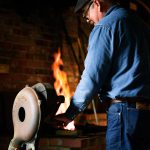Magnets in Bladesmithing
Originally on the History Channel, Forged in Fire, has been taking over Netflix with its cutthroat competition between bladesmiths. Each episode has the bladesmiths recreate historical edged weapons — from Roman Gladius, Viking battle axes, Napoleon’s saber, and more.
What caught our attention here at Apex is their use of magnets during their heat treating so we're diving into the why, how, and “does it actually work,” below!
Why a Magnet Helps in Heat Treating
Like portrayed in the show, it’s pretty common for knifemakers to use a forge or torch to heat treat alloy steels. With both of these options, temperature control isn’t possible as you’re using a flame that’s not temperature controlled for the heat source. But, knowing the temperature is crucial in bladesmithing — if you let your material get too hot it can cause warps or even cause the metal to crack.
One way to gauge the temperature is by using a magnet to test the magnetic ability of the steel. You can watch it here, but essentially, once the metal is heated to the critical state, it loses its magnetism. So, by running a magnet intermittently during the forging process, you can get a good time frame of the temperature.
How Does This Work?
Iron and steel is “ferromagnetic” which means they are permanently magnetic. While they’re “permanently magnetic” this doesn’t mean it can never be demagnetized. Instead, the permanence comes from being objects with strong magnetic attraction, regardless of whether or not they are in the presence of a magnetic field. How a material becomes ferromagnetic is when “magnetic moments” of the iron atoms become aligned (which are attracted to a magnet). Each material has magnetic “domains” with their own magnetic moments. To be attracted to a magnet, each domain with their own “moment” has to be aligned.
Ferromagnetic temperatures have a “Curie temperature” where once it reaches this temperature, it will no longer be attracted to a magnet. This Curie temperature, also known as Curie point, is the temperature that enough energy is in the metal to break up the long range order of the magnetic domains. The Curie point is different between metals — about 770°C (1420°F) for iron, 1127°C (2060°F) for cobalt, and 354°C (670°F) for nickel.
Is This Method Reliable?
Yes, for the most part. The issue with this method is you don’t know the exact moment that the temperature reaches the point. So, it’s not completely fool-proof. But, imperfections are what make each piece unique, and unless you’re on the show, your knife/weapon won’t be gruelly tested. Experienced blacksmiths can find success in using this method as they are also looking for things like the color of the blade as well as using the magnet test. So, this test alone may not always give the results you want but it’s a great way to gauge the temperature.
Learn More With Apex Magnets
If you’re like us and watching the show has sparked a want to take up bladesmithing, neodymium magnets like the ones we sell at Apex would be great to use. If you liked this reality TV vs real life spotlight, check out our previous blog post talking about magnet use in Stranger Things.

